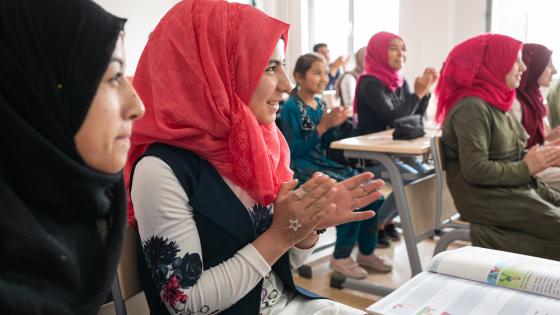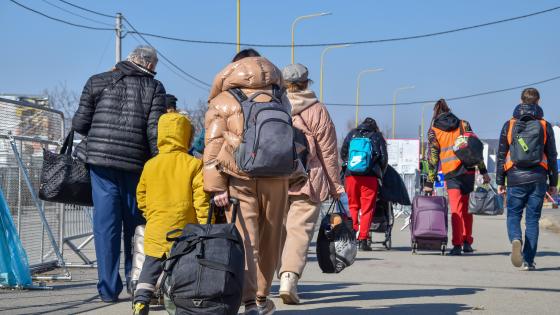The so-called European refugee crisis that erupted in 2015 has raised concerns about the potential proneness to violence of migrants fleeing war zones. Various mechanisms explain why people tend to reproduce violence when they have perpetrated or witnessed violence in the past – psychological trauma, a collapse of trust and moral values, or economic deprivation, to name a few. Beyond case studies and anecdotes, it turns out that the identification of a causal impact of past exposure to conflict on future likelihood of violent behaviour is challenging. The reason is simple. In most cases people remain in the same environment where war breaks out in the first place, which makes it hard to isolate the individual effects of war exposure from the impact of the surroundings (e.g. weak institutions, natural resource abundance or ethnic cleavages). This lack of scientific evidence is worrying since the vicious cycles between poverty and war recurrence are key issues in development economics, and are of foremost importance for post-conflict reconstruction. More than two thirds of all war outbreaks took place in countries where multiple conflicts have been recorded (Collier and Hoeffler 2004) and many studies find that past wars are strong predictors of future wars (e.g. Walter 2004).
Asylum seekers in Switzerland
In a recent study (Couttenier et al. 2016) we analyse empirically whether the past exposure to conflict in origin countries makes individuals more violence prone in their host country. We focus on asylum seekers in Switzerland – a federal state with 26 cantons, a population of about 8 million people, and a strong humanitarian tradition. We observe a yearly average number of 30,000 asylum seekers over 2009-2012, a period that overlaps with the start of the Arab Spring. Young males represent the bulk of refugees (75% of males, of whom 58% are below the age of 30). Among the 134 countries of origins, conflicts occurred in 90, and mass killings in 27 countries since 1960. A substantial part of asylum seekers do not flee their country during war time, but years or even decades afterwards.
Are refugees from war zones more violence prone?
For the purpose of studying violent crimes perpetrated by asylum seekers, we exploit an original dataset collected by the police on all detected crimes in Switzerland. It has a unique feature: the nationalities of victims and perpetrators and their legal status are reported. An important remark is that the population of migrants we analyse is composed of asylum seekers benefitting from the legal right to stay during the evaluation process, so whether they are filed for having committed a crime cannot be due to illegal status. We first observe that intra-refugee violence is over-represented: 35% of victims are themselves asylum seekers, 28% are foreign residents, 36% are natives. Second, their crime propensity is 2%, i.e. on average 2 refugees out of 100 commit a crime. We deliberately avoid comparing the crime propensity of refugees to the crime propensity of native residents or other economic migrants, as this comparison could be biased by many (un-)observed factors.
Our primary interest lies in understanding whether past exposure to conflict increases current violent behaviour, i.e. the ‘does violence breed violence?’ question. Here we interpret conflict exposure in a broad sense that encompasses direct and indirect forms of victimisation, such as being personally targeted by acts of violence (e.g. being injured or witnessing the killing of a family member) or being exposed to a war context with prevailing economic deprivation and social capital depletion. To rule out former war perpetrators from the analysis we focus for each nationality on a specific group, namely individuals who were children in wartime; a group that we compare to their co-nationals born after the conflict.
Figure 1 explores the age-crime nexus by reporting average crime propensity by age bracket for the two groups at the core of our analysis: cohorts exposed to civil conflict during childhood between the age of 1 and 12 (in red) and those born after conflict (in blue). For the two groups, we see a clear spike in violent crime in early adulthood and then a steady decrease across ages. Pattern and magnitude confirm the large evidence on age-crime curves in the criminology literature for other populations-periods (see Freeman 1999, for a review on determinants of criminal behaviour). The striking and novel point here relates to the crime differential between the two groups; while for very young cohorts the crime propensity is high for any of the two groups, from the age of 20 an important gap widens up.
- In particular, cohorts with past exposure to conflict keep having high crime propensities until the age of around 40, while for cohorts born after conflict, the crime propensity drops already massively from age 21 onwards.
After the age of 40 the two curves converge again on a low level. Across the considered age brackets, the average differential is equal to 0.85 percentage points, a substantial wedge that implies that cohorts exposed during childhood are on average 1.75 times more prone to violent crimes than cohorts born after a conflict. Our interpretation is that past exposure to conflict during childhood prevents the dampening effect of age on violence to take place.
This graphical evidence illustrates our main result. Our econometric analysis confirms that this excess crime propensity is causally related to the exposure to violence in childhood, accounting for a variety of potential confounding factors. We also show that this violence premium is present both for civil conflict and mass killing exposure, and is attenuated for women, for property crimes, and for low-intensity conflicts. We further examine potential channels of transmission. Controlling for school enrolment, democracy scores and GDP per capita during the first 12 years of age of a given cohort, does not affect the estimated impact of conflict exposure, suggesting that it is unlikely that the mechanism at work is purely based on human capital depletion and economic deprivation. Making use of information on the nationalities of both perpetrators and victims, we show that the over-propensity to target victims from their own nationality is more than doubled for cohorts exposed to conflict during childhood. This is consistent with theories of war recurrence stressing the role of persistence in intra-national grievances and hostility (Rohner et al. 2013).
Figure 1. Crime propensity by age bracket

The role of public policies for integrating asylum seekers
We also exploit the fact that Switzerland is a federal state with large variations in institutions and public policies across its 26 cantons. Our question of interest is whether there exists some set of integration policies that can mitigate the risk of increased criminality for conflict-exposed individuals.
Our main finding is that offering labour market access to asylum seekers can strongly reduce the effect of conflict exposure. In particular, in the presence of the unlimited opportunity to apply rapidly for jobs in all sectors the violence premium of past conflict exposure drops massively – the economic rationale being that the outside option of paid employment affects the opportunity cost of engaging in criminal activity. We also document a crime-reducing effect of policies resulting in a longer time horizon for asylum seekers in Switzerland, such as a higher nationality-specific acceptance rate and the absence of a readmission agreement enabling expulsion by force.
Policy message
Besides being of academic interest, the question of what factors could make immigrants crime prone is also of big societal importance. In many developed western countries this topic fuels heated and politically loaded debates, triggering the rise of populist parties. In this respect, one policy relevant conclusion of the current paper is that the crime risk of asylum seekers with conflict background can be very strongly reduced by putting in place public policies that offer opportunities, and at the same time get the incentives right for law-abiding behaviour.
Do the results of the paper advocate a more restrictive immigration policy? Not by any means. Still, the legitimate need for protection of refugees needs to be traded-off against the legitimate demand for domestic security. A well-funded asylum system offering rapid access to local labour markets and providing future perspectives and opportunities for integration can limit the risk of an increase in crime perpetrated by migrants with a conflict background. With respect to the current refugee crisis our research suggests three arguments in favour of maintaining a generous asylum policy:
- Asylum seekers flee a life-endangering environment and need protection.
- Hosting them does not increase criminality when the right integration policies are implemented.
- Providing shelter contributes to stopping the vicious circle of violence breeding violence in their origin countries. By contrast, abandoning them would create a lost generation and increase the risk of future wars and recurrent refugee waves.
References
Collier, P and A Hoeffler (2004), “Greed and Grievance in Civil War”, Oxford Economic Papers, 56: 563-95.
Couttenier, M, V Preotu, D Rohner and M Thoenig (2016), “The Violent Legacy of Victimization: Post-Conflict Evidence on Asylum Seekers, Crimes and Public Policy in Switzerland”, CEPR Working Paper DP11079.
Freeman, R B (1999), “The Economics of Crime”, Chapter 52 in O Ashenfelter and D Card, Handbook of Labor Economics, Vol. 3, Amsterdam: Elsevier Science.
Rohner, D, M Thoenig, and F Zilibotti (2013), “War Signals: A Theory of Trade, Trust and Conflict”, Review of Economic Studies, 80: 1114-1147.
Walter, B (2004), “Does Conflict Beget Conflict? Explaining Recurring Civil War”, Journal of Peace Research, 41: 371-88.







